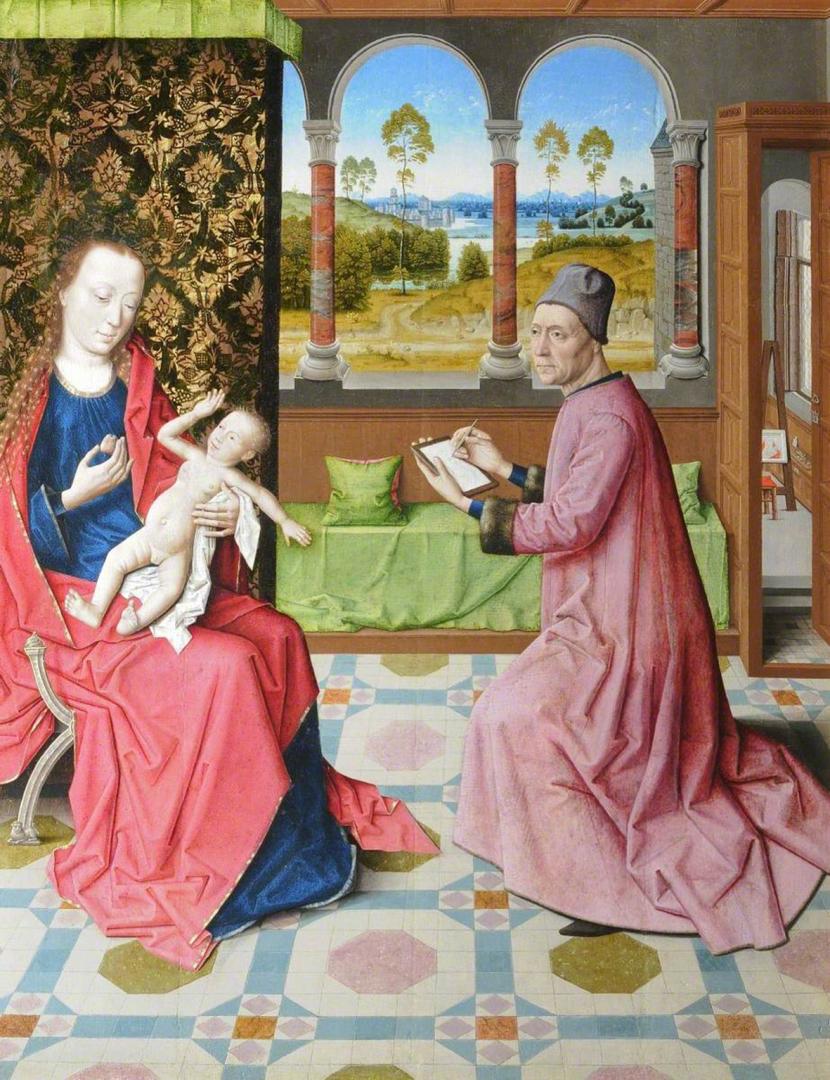In another of her occasional columns, Dorothy Blundell takes a sideways look at the collections of The Bowes Museum, where she volunteers
SELFIES are not a new concept. Painters through the ages often did self-portraits and some went further, showing themselves at work.
Take this (sort of) medieval selfie of a 15th century Netherlandish artist (pictured right). Its title: St Luke Drawing the Virgin and Child.
It is attributed to the workshop of Dieric Bouts the Elder (c1400-1475), in other words, Bouts’ apprentices.
It is thought it shows Bouts (pronounced with an ‘ow’ as in owl) – or perhaps one of those who commissioned it – as St Luke doing preparatory sketches before moving to work on his prepared canvas which can be glimpsed on the easel in his studio, through the open door on the right.
Legend has it that St Luke painted the Virgin and infant Jesus, possibly from life.
Such depictions were popular throughout the middle ages and renaissance. Netherlandish paintings were usually painted in oil, often religious scenes or small portraits, with richly detailed backgrounds.
They were admired for the visual sophistication, imagination and invention, and this example in particular is of major importance because of its connection with Bouts.
He was one of the most influential painters of his time with a highly distinctive style of angular, elongated characters and techniques with oils, such as painting on top of wet paint – known as wet on wet.
Works by Bouts (his real name was Theodorik Romboutszoon), are rare, especially in the UK. It is believed that there are no other paintings of this subject from the time (1440-1460) in British public collections.
Consequently, when it came up for sale in 2015 it was the subject of an export ban. It was acquired in July 2016 by The Bowes Museum for just under £2.3million, with support from Art Fund, Heritage Lottery Fund and a number of private donors.
The painting resembles a composition by Rogier van der Weyden in Boston’s Museum of Fine Arts, which, in turn, was based on a painting by Jan Van Eyck in the Louvre.
It was bought in 1850 by Edward, Lord Penrhyn for about £100, even though he reportedly “never cared for it at all” .
In 1899, because of its poor condition, it was transferred from wood panel to canvas and in doing so, many historic repairs were discovered. Luckily, the heads and figures and all important parts of the picture were intact.
When a conservator with the National Gallery examined the painting in 2016 using X-rays, infrared light and microscope, the combined results revealed fascinating insights into the development of the work.
They included underdrawing details showing different positioning of hands and draped folds of fabric, and how there might once have been an intention for a huge halo around the head of the Virgin.
There are also flecks of blue in the white of the Virgin’s eye to make it look especially white against the pink flesh tones. But the significance (no devils here) is in the detail.
If you squint at the wall shelf next to the easel in the studio beyond the door you will see mussel shells (microscopic view of the shells’ blue tinge confirmed this). Empty of resident molluscs, these were used as handy receptacles for artists to carry their home-made paints.
As for the larger detail, Dr Howard Coutts, keeper of ceramics at The Bowes Museum, said in a blog a few years ago that architectural historians might question the balcony being right for the period and that the floor, despite “looking alarmingly like Minton ceramic tiles from the 19th century, must have been stone of coloured marble appropriate to the dwelling of the high ranking lady” .
He added: “What on earth is the chair she is sitting on, with its strange curving X-frame that looks as if it has come out of a Hollywood props department? My guess is that the artist… knew of biblical chairs from church teachings and other religious paintings, and decided this was appropriate to his depiction.”
Part of the funding deal to buy the painting was to use it, in partnership with Bristol Museum and Art Gallery and York Museums Trust, as the focus of a five-year programme of events.
So, having been away for almost three years, St Luke Drawing The Virgin and Child returned to The Bowes Museum last August and since then, has been sparking creativity among hundreds of young people, through online art workshops and competitions.
A Bouts Festival is taking place during half term next week.
Redisplaying the painting was the first task of the Young Curators, a new group of six young people (aged 13-25), including a student from Teesdale School, who are working in collaboration with the museum to implement events inspiring others of their age to get involved with art.
Even though the museum is closed, you can meet the Young Curators on the museum website and visit their exhibition, called Working From Home With Bouts, because there is an amazing online 3-D video (thebowesmuseum.org.uk/Learn/Young-People/Young-Curators).
It allows you to virtually see around the exhibition and gallery from the comfort of your armchair. Until the museum is once again open to visitors, it is the next best thing to being there.
Explore the collection online at thebowes museum.org.uk






